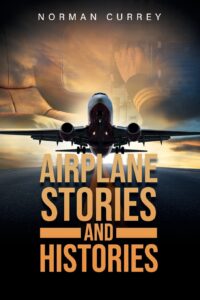Title: Airplane Stories and Histories
Author: Norman Currey
Publisher: Writers’ Branding LLC
ISBN: 978-1-953048-68-4
Pages: 180
Genre: Aviation / Military History
Reviewed by: Jason Lulos
Hollywood Book Reviews
 Since the first humans who spotted birds in the sky, people have been enchanted with the idea of flight. Although birds have mastered the art over many millennia, human flight is still relatively new but similarly captivating in its transcendent technology over the last century and a half. In Airplane Stories and Histories, author Norman Currey chronicles this remarkable story, adding historical context and personal anecdotes from his own career in aviation. Currey’s clearly evident expertise and thoughtful asides make this a really engaging and informative volume.
Since the first humans who spotted birds in the sky, people have been enchanted with the idea of flight. Although birds have mastered the art over many millennia, human flight is still relatively new but similarly captivating in its transcendent technology over the last century and a half. In Airplane Stories and Histories, author Norman Currey chronicles this remarkable story, adding historical context and personal anecdotes from his own career in aviation. Currey’s clearly evident expertise and thoughtful asides make this a really engaging and informative volume.
Norman Currey begins with a brief introduction on his personal history which dates back to the Air Training Corps in the UK during WWII; after which he worked with Avro Canada and Lockheed for 10 and 30 years respectively. He then discusses the early pioneers such as Sir George Cayley, Lindbergh, Amelia Earhart, Wiley Post, and of course, the Wright Brothers. As war has been the primary mover in aircraft development, there are copious discussions and wonderful photographs of warplanes i.e. the Spitfire and the Mustang, but equal space is given to commercial airliners i e. the 747s and the Concorde.
Currey keeps the book as non-technical as possible, so it will appeal to anyone interested in flight the “armchair engineer” as he calls it as well as the aviation pro. His insider “fun facts” make for fast-paced, relatively jargon-free, compelling stories. He covers a great deal, including a veritable family tree of aircraft gliders to bombers to passenger planes that now fly at 1500 mph. The author’s love for aviation and thoughtful writing turns a compendium of scientific advancements into a collection of vignettes that form a complete story/history. He even makes the evolution of landing gear sound interesting!
At times, the author touches on the intriguing paradox of aviation. It literally brings people of different nations together, but its advancements have been largely directed by an arms race. This is thought-provoking to say the least.
The book concludes with updates on newer technologies: alternative fuel, drones UAVs -which can be used to aid in things such as border control and natural disasters, and the wildly interesting idea of “morphing” – the ability to change wing shape and size: modeled after birds of course. And there is the Boeing Phantom Eye which flies on liquid nitrogen and has only one byproduct: water! Forgive the pun, but the sky’s the limit with how far aviation technology can go. With so many compelling accounts in this book, it will certainly appeal to anyone even remotely interested in human flight.

